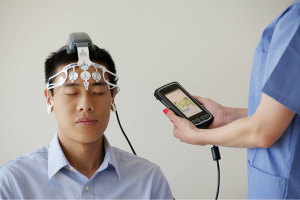Electroencephalogram (EEG)

What is an EEG?
An Electroencephalogram (EEG) is a safe, painless, and non-invasive test that records electrical activity in the brain. It is commonly used by neurologists and psychiatrists to diagnose and monitor conditions affecting brain function, such as epilepsy, sleep disorders, and psychiatric conditions.
How Does an EEG Work?
The brain cells (neurons) communicate using electrical impulses. An EEG records these impulses through small sensors (electrodes) placed on the scalp. These electrodes detect electrical signals from different parts of the brain and send them to a computer, which then displays the results as wave patterns. Doctors analyze these wave patterns to identify any abnormalities.
Why is an EEG Done?
An EEG helps in diagnosing various neurological and psychiatric conditions, including:
- Epilepsy and Seizures – EEG can detect abnormal electrical activity, helping doctors confirm and classify seizure types.
- Sleep Disorders – It is used to study sleep patterns and diagnose conditions like insomnia, narcolepsy, and sleep apnea.
- Brain Tumors or Injuries – EEG can provide clues about brain damage or abnormalities caused by trauma, stroke, or tumors.
- Dementia and Alzheimer’s Disease – It helps in assessing cognitive decline and changes in brain function.
- Psychiatric Disorders – Conditions like depression, schizophrenia, and bipolar disorder may show distinct EEG patterns.
- Unexplained Fainting or Memory Loss – EEG can help determine if these symptoms are linked to abnormal brain activity.
How to Prepare for an EEG?
EEG does not require any major preparation, but here are a few things to keep in mind:
- Wash Your Hair – Avoid using conditioners, oils, or gels, as they may interfere with electrode placement.
- Avoid Caffeine – Coffee, tea, and energy drinks should be avoided before the test, as they can alter brain activity.
- Follow Sleep Instructions – In some cases, you may be asked to sleep less the night before for a sleep EEG.
- Continue Medications – Inform your doctor about any medications you take, but do not stop them unless advised.
What Happens During an EEG?
The EEG procedure is simple and takes about 30-60 minutes. Here’s what to expect:
- You will sit or lie down in a comfortable position.
- A technician will place small, flat metal discs (electrodes) on your scalp using a special adhesive or cap.
- You may be asked to perform simple tasks like opening and closing your eyes, breathing deeply, or looking at flashing lights.
- The machine records your brain’s electrical activity.
- After the test, the electrodes are removed, and you can resume normal activities immediately.
Are There Any Risks Involved?
EEG is completely safe and does not cause any pain. It does not involve radiation or electric shocks. In rare cases, if you have epilepsy, certain triggers during the test (such as flashing lights) may induce a seizure, but medical professionals are always present to handle such situations.
Understanding EEG Results
The results of an EEG are interpreted by a specialist. Normal brain activity appears as a predictable pattern of waves. Any irregularities may suggest a neurological disorder. Based on the findings, your doctor may recommend further tests or treatment options.
